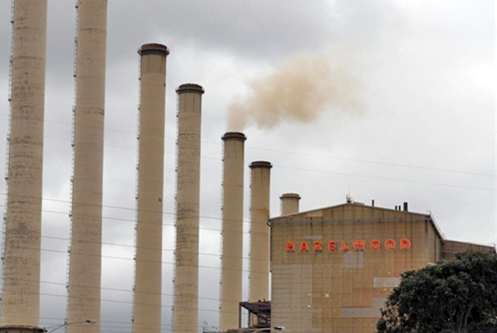We now have evidence that Australia’s carbon price scheme was working, plus some strong indications that its replacement will be a dud. [30 December 2014 | Peter Boyer]
Two days before Christmas, without a murmur, the federal government let slip a report showing that the carbon pricing scheme it ditched last June was actually doing the job it was meant to do.

Hazelwood brown coal power station in Victoria’s Latrobe Valley, a major source of Australian carbon emissions. PHOTO ABC
The government is obliged by law to release quarterly reports of the National Greenhouse Gas Inventory. This one shows that in 2013-14, the second and final year of the scheme’s operation, total emissions were 1.4 per cent below the previous year’s total.
A decisive 4 per cent decline in coal-fired power generation was the main cause of the big drop. At the same time, hydro generation rose by 1.8 per cent and wind and other renewable power by a remarkable 27.5 per cent. Not a bad result if you’re aiming to wean the economy off coal.
After a much smaller drop in emissions in the pricing scheme’s first year, environment minister Greg Hunt released a media statement headed “Carbon tax is still all pain, no gain”, ignoring advice from the scheme’s architects that it would take multiple years to become fully effective.
Now we have data to say it was working, yet Hunt and his leader, Tony Abbott, want us to believe that getting rid of it was their great gift to the nation. Abbott put it at the top of his list of 2014 achievements.
Energy consultants Pitt and Sherry analyse energy data for a monthly carbon emissions index they call CEDEX. Since renewable energy lost its carbon price advantage in June, CEDEX reports have shown generation from hydro, solar and wind flattening out.
The same period has also seen a sharp uptick in brown and black coal generation, the biggest single source of Australian emissions. CEDEX concludes that “June 2014 may mark the low point of Australia’s greenhouse gas emissions for the foreseeable future.”
Questions: Will the government be able to sustain its position that ditching carbon pricing was a good idea? Will its own Emissions Reduction Fund (ERF), due to crank up within six months, get emissions trending down again, or will it prove to be an ineffectual and costly mistake?
The Climate Change Authority’s task is to analyse climate policy options. In June the Senate voted down Tony Abbott’s plan to scrap the authority, which means the government must continue to endure its close scrutiny.
The authority is required to do three-yearly reviews of the Carbon Farming Initiative (CFI), a program set up by Labor which the Abbott government has kept because it’s useful as a platform on which to build its own ERF.
But merging the CFI with the ERF has put the government’s own economy-wide scheme within the legal scope of the Climate Change Authority’s first CFI review, released on December 22. This is scrutiny the government would have preferred to avoid.
The authority gave the government credit for lengthening investment periods to give more security for investors, offering greater encouragement to develop better emissions-reduction methods, and creating more flexible reporting arrangements. But the plaudits end there.
The review found that rapidly scaling the CFI up to ERF level would increase the risk that public funds would be paid out for emissions cuts that would have happened anyway, without any scheme, and that bureaucratic controls to prevent this were likely to be very costly.
The authority’s report said strong safeguards and access to as many tools as possible were essential. But safeguards are “still in the design stage” and the government has ruled out the tool which the World Bank says has become the favoured option elsewhere in the world – a price on carbon.
The authority also found that ERF funding was likely to be far short of what would be needed to get us to the bipartisan target requiring Australia’s emissions in 2020 to be 5 per cent below where they were in 2000.
Economist Ross Garnaut and the Climate Institute have separately calculated that to reach this unambitious target, the ERF would need extra funding of at least $1.5 billion and possibly as much as 10 times that. There’s no chance the government will find that sort of money.
At least those conclusions were based on verifiable modelling and data. All Greg Hunt has offered in support of the ERF are his own bland assurances. This is no way to conduct government.
The lag time in assessing emissions means we won’t have a conclusive verdict on the ERF until after the 2016 elections, which is convenient for the government. But there are ominous portents that over coming years this unsupported, untested policy will turn into a slow train wreck.
It may yet be saved by, you guessed it, a carbon price. As part of a deal with Clive Palmer, Hunt has asked the authority to “assess whether Australia should have an emission trading scheme” – exactly what we’d have ended up with if the previous scheme had been left alone. Ah, politics.
